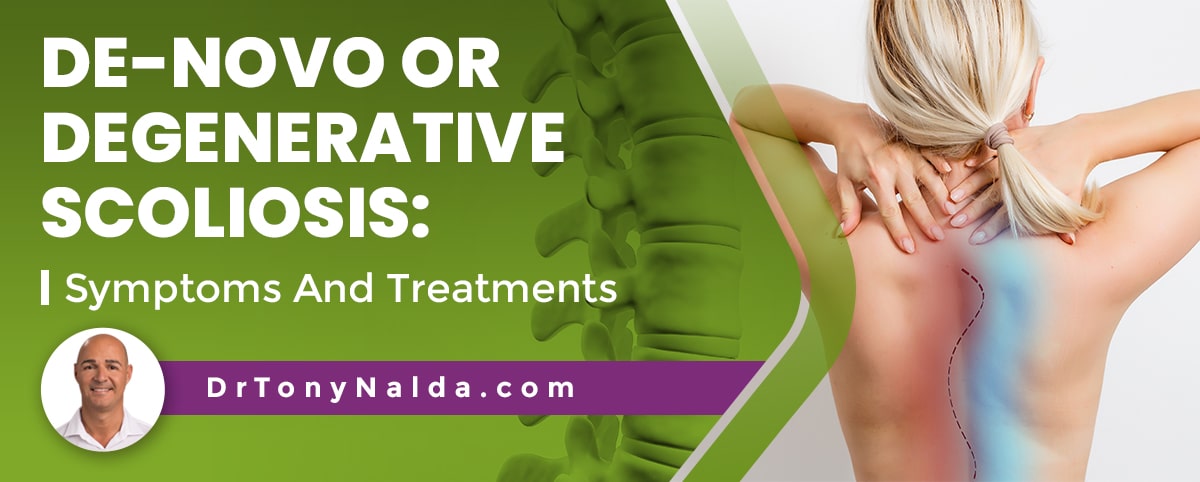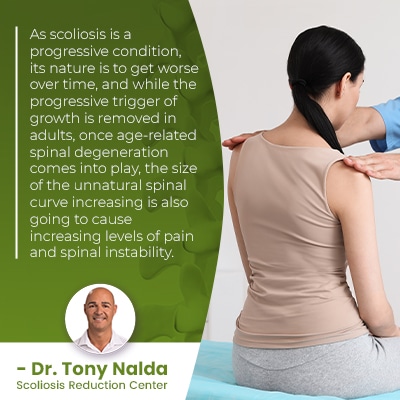De-Novo Or Degenerative Scoliosis: Symptoms And Treatments

While scoliosis is most commonly diagnosed in adolescents, it also affects adults; in fact, the actual rate of scoliosis increases in the aging population as spinal degeneration becomes a factor. Degenerative scoliosis is most common in adults over the age of 50, and the best time to start treatment is always now.
No two cases of scoliosis are the same; the condition's complex nature necessitates the customization of effective treatment plans. In addition to ranging widely in severity, there are also different types of scoliosis, determined by causation. Degenerative scoliosis is caused by natural age-related spinal degeneration.
As a patient's scoliosis-experience starts with a diagnosis, let's start there.
Table of Contents
Diagnosing Scoliosis
Scoliosis is a highly-prevalent spinal condition; the Scoliosis Research Society has current estimates at close to seven million people living with scoliosis in the United States alone, and it's the most common spinal condition amongst school-aged children.
Because scoliosis is such a highly-variable condition, part of diagnosing scoliosis involves further classifying conditions based on key patient/condition variables, and this helps streamline the treatment process and shapes the crafting of effective treatment plans.
Scoliosis is the development of an unnatural sideways spinal curve that not only bends unnaturally to the side, but also twists, and it's the rotational component that makes it a complex 3-dimensional condition.
Scoliosis is classified based on patient age, condition severity, curvature location, and condition type, and type is where de novo, aka degenerative scoliosis is classified.
Condition Type
In addition to the fact that scoliosis ranges widely in severity from mild to moderate and severe to very severe, there are also multiple different types of scoliosis a person can develop, and type is determined by a condition's underlying cause.
 Now, in approximately 80 percent of known diagnosed cases, the cause of scoliosis is unknown, and this is classified as idiopathic scoliosis: not clearly associated with a single-known cause.
Now, in approximately 80 percent of known diagnosed cases, the cause of scoliosis is unknown, and this is classified as idiopathic scoliosis: not clearly associated with a single-known cause.
Idiopathic scoliosis is thought to be multifactorial, meaning caused by a combination of variables that can vary from one patient to the next.
The most prevalent form of scoliosis overall is adolescent idiopathic scoliosis, diagnosed between the ages of 10 and 18.
So most cases of scoliosis have an unknown cause, but what about the remaining 20 percent? Atypical types of scoliosis are associated with known causes, and this includes neuromuscular scoliosis, congenital scoliosis, and degenerative scoliosis.
Neuromuscular scoliosis is caused by the presence of a larger neuromuscular condition such as spina bifida, muscular dystrophy, and cerebral palsy, and as the neuromuscular condition is the underlying cause of the scoliosis, it has to be the focus of treatment.
Congenital scoliosis is a rare type affecting approximately 1 in 10,000; it's caused by a malformed spine that develops in utero, so babies are born with the condition.
Degenerative scoliosis occurs over time as the spine faces age-related degenerative changes.
What is Degenerative Scoliosis?
The spine's natural curves are important; they make the spine stronger, more flexible, and better able to handle mechanical stress incurred during activity.
Degenerative scoliosis is caused by natural age-related spinal degeneration, so is most commonly diagnosed in adults over the age of 50; females are also diagnosed more often than males due to spinal instability caused by hormone and bone density changes related to menopause.
The cumulative effect of certain lifestyle choices also plays a role in the rate and level of age-related spinal degeneration a person experiences; carrying excess weight, a sedentary lifestyle, chronic poor posture, repeatedly lifting heavy objects incorrectly, and excessive consumption of alcohol and/or smoking.
Degenerative scoliosis is also known as de novo scoliosis, meaning develops fresh with no prior history.
Degenerative scoliosis is the second most common type to affect adults, after idiopathic scoliosis, and cases of adult idiopathic scoliosis are actually cases of adolescent idiopathic scoliosis that went undiagnosed and untreated during adolescence.
Scoliosis is a progressive condition, so has it in its nature to get worse over time, and when left undiagnosed and untreated, adolescent idiopathic scoliosis can progress with time and maturity into adulthood; this is a common scenario as scoliosis doesn't become a compressive condition until skeletal maturity has been reached, and then it becomes painful.
In fact, it's pain that brings the majority of my adult patients in for a diagnosis and treatment.
So unlike adult idiopathic scoliosis, degenerative scoliosis develops fresh in adulthood, and patients with degenerative scoliosis have degenerative changes to their spine making it increasingly unstable and unable to maintain its natural curves and alignment.
Symptoms of Degenerative Scoliosis
 Scoliosis introduces a lot of uneven forces to the body that can cause a variety of symptoms.
Scoliosis introduces a lot of uneven forces to the body that can cause a variety of symptoms.
While condition severity is an important factor, some common symptoms of adult degenerative scoliosis can include a loss of height, pain, neck aches/headaches, and mobility issues.
As it's most often the spinal discs that are the first spinal structures to start to deteriorate, this often involves one or more intervertebral discs becoming desiccated and losing height as a result, and this can account for patients with degenerative scoliosis experiencing a loss of vertical trunk height.
Pain is common as the spine becomes increasingly unstable, and as the discs degenerate, their change in shape can cause compression of their surroundings, which includes adjacent vertebral bodies, and surrounding muscles and nerves.
As an unnatural scoliotic curve develops in adults, it compresses the spine and its surroundings, and compression of the spine, surrounding nerve roots, and muscles is the main cause of condition-related pain.
As scoliosis is a progressive condition, its nature is to get worse over time, and while the progressive trigger of growth is removed in adults, once age-related spinal degeneration comes into play, the size of the unnatural spinal curve increasing is going to cause increasing levels of pain and spinal instability.
Degenerative Scoliosis Treatment Options
Here at the Scoliosis Reduction Center, I address scoliosis proactively by starting treatment as close to the time of diagnosis as possible, and particularly when it comes to degenerative scoliosis, this is important because the goal is to prevent further damage, stabilize the spine, and manage pain.
While in my younger patients facing rapid progression, a significant curvature reduction is the main goal, in adults, while I still want to reduce the size of the scoliotic curve, the goal is more so to reduce it back to the size it was prior to becoming painful.
Lifestyle guidance is also important, particularly if I see lifestyle factors that are problematic for spinal health.
I apply a conservative chiropractic-centered treatment approach that integrates condition-specific chiropractic care, physical therapy, corrective bracing, and rehabilitation to impact degenerative scoliosis on every level.
Chiropractic care can help adjust the position of the curve's most-tilted vertebrae, and physical therapy and scoliosis-specific exercises can help patients increase their core strength so their spines are optimally supported and posture is improved.
Corrective bracing, when used in adult treatment, is more about stabilizing the spine and providing short-term pain relief; when treating childhood scoliosis, it's more about helping to achieve significant curvature reductions.
Degenerative scoliosis can develop anywhere in the spine but most commonly affects the lumbar spine as degenerative lumbar scoliosis, and this is because the lumbar spine has the added roles of supporting the weight of the entire trunk, the spinal sections above, and the lumbar vertebrae feel the effects of turning, bending, lifting, and twisting motions.
Rehabilitation is important for long-term sustainable treatment results and involves a series of custom-prescribed home exercises for further stabilizing and healing the spine.
Conclusion
So a classification of de novo and/or degenerative scoliosis is given if an adult has developed scoliosis in adulthood with no prior history with the condition in adolescence.
Most patients with degenerative scoliosis are over the age of 50, and while scoliosis is more commonly diagnosed in children, the rate of scoliosis increases with age because of age-related spinal degeneration.
When it comes to spinal degeneration, it's commonly the intervertebral discs that are the first spinal structures to start to deteriorate, and when this happens, discs can become desiccated, shrink, change shape, and compress their surroundings.
Surgical treatment for scoliosis only gets increasingly risky with age, and risks associated with spinal fusion surgery include spinal nerves being damaged, excessive blood loss, and infection; in addition, surgical intervention is associated with decreased levels of spinal flexibility and range of motion that can disrupt quality of life.
While there are never treatment guarantees, patients with degenerative scoliosis can achieve condition improvement through conservative non operative treatment that's less invasive, risky, can help alleviate pain, and effectively slow the degenerative process.
Dr. Tony Nalda
DOCTOR OF CHIROPRACTIC
After receiving an undergraduate degree in psychology and his Doctorate of Chiropractic from Life University, Dr. Nalda settled in Celebration, Florida and proceeded to build one of Central Florida’s most successful chiropractic clinics.
His experience with patients suffering from scoliosis, and the confusion and frustration they faced, led him to seek a specialty in scoliosis care. In 2006 he completed his Intensive Care Certification from CLEAR Institute, a leading scoliosis educational and certification center.
About Dr. Tony Nalda
 Ready to explore scoliosis treatment? Contact Us Now
Ready to explore scoliosis treatment? Contact Us Now





